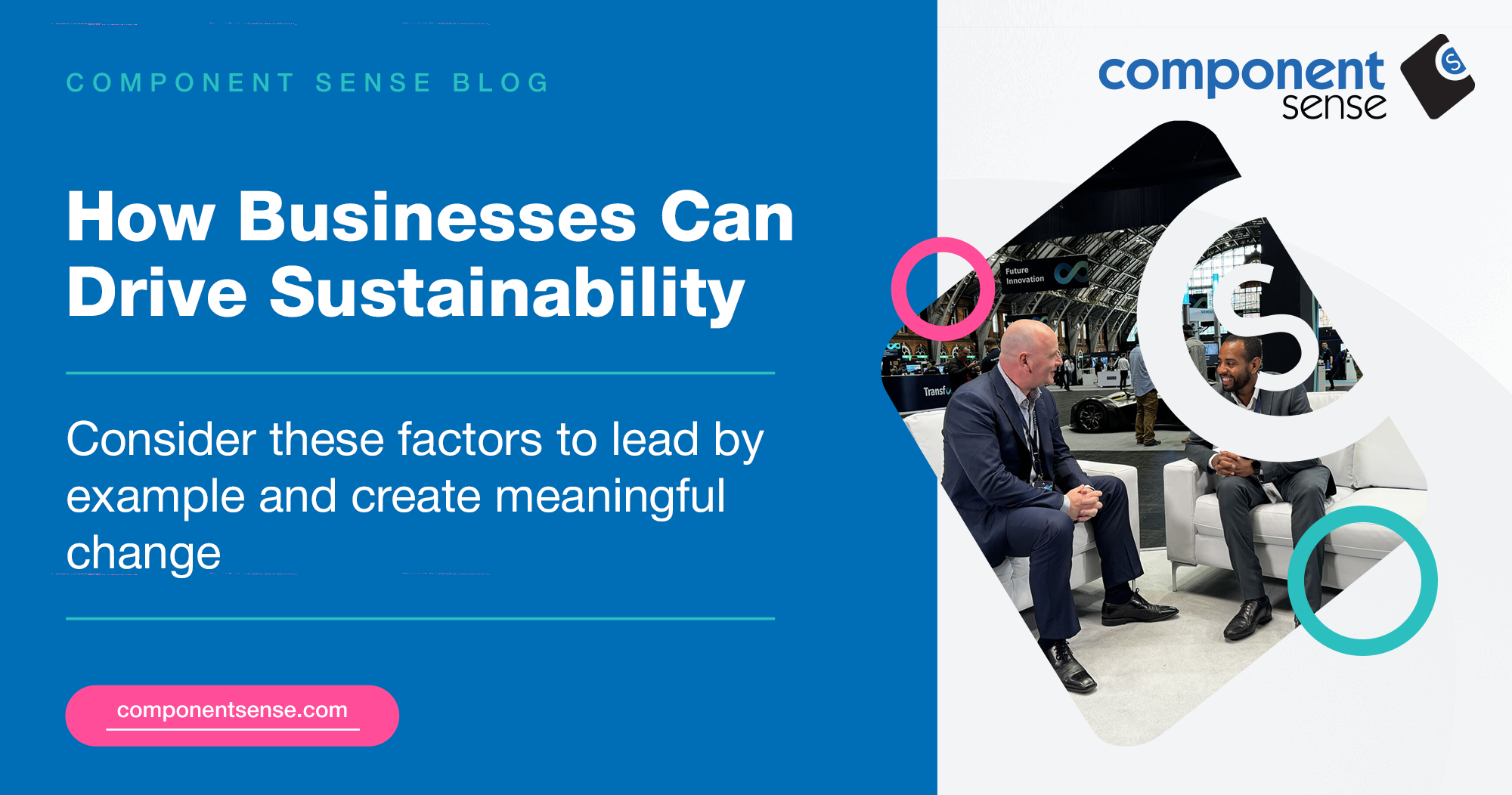How Businesses Can Drive Sustainability

To be a sustainable business, you must strategise and take action to minimise, reverse, and offset any social and environmental damage caused by your operations.
After attending Siemens Transform 2024 and Reset Connect 2024, our team at Component Sense considered how businesses can create lasting positive environmental change. What are successful sustainability-minded companies doing right?
There are plenty of reasons to prioritise sustainable business practices. Consider these factors for your own ESG (environmental, social, and governance) journey.
Current sustainability landscape
Increasing global warming and harmful practices persist despite high interest rates, inflation, and rising awareness of environmental issues. Following a global pandemic and amidst a cost of living crisis, work continues to be carried out to meet international climate goals, including:
- The United Nations Sustainable Development Goals (SDGs): 17 SDGs, including 169 sustainability targets agreed on by UN member states to be achieved by 2030.
- Paris Agreement: A legally binding climate treaty agreed on by 196 parties to limit global warming to 1.5 degrees Celsius above pre-industrial levels.
As of 2023, 81 countries have electronic waste (e-waste) legislation, an increase from 78 in 2019. In addition, introducing EPR (extended producer responsibility) policies is seeing more manufacturers become accountable for their products across the entire lifecycle.
Despite the economic landscape, consumers still look to encourage sustainable practices with their wallets. Many buyers are looking for signs of environmentally responsible companies, including:

Methods to make a sustainable difference
Large companies, including electronic manufacturers, play a significant role in reducing their environmental footprint and inspiring others to change their wasteful ways. Most sustainable businesses recognise the electronics industry's impact on the environment, which has led to strategy pivots and CSR (corporate social responsibility) initiative rollouts.
To become a top sustainable company, you need a clear plan and stakeholder buy-in. A framework with time-bound actions ensures truly meaningful progress. Here are some sustainable business practice examples you may want to consider.
Sustainable innovation
Sustainable innovation can be viewed in multiple ways. On one hand, manufacturers may focus their business mission on creating renewable technologies or equipment that minimises global warming. On the other hand, sustainable innovation can simply mean designing products with minimal or no environmental footprint.
Beyond solar panel advancements and plug-in vehicles, electronic manufacturers are encouraged to develop products that are easier to repair and have longer lifespans. Planned obsolescence, which encourages consumers to upgrade their devices instead of repairing them, is a key contributor to e-waste.
Dutch smartphone company Fairphone exemplifies designed longevity. Its Fairphone 4 is made of eight modules that end-consumers can repair. In fact, Fairphone also provides guides and spare parts on their website to encourage less waste.

Strategic partnerships
Businesses, especially larger companies, sometimes do not realise their influence. Opting out of environmentally harmful deals or choosing eco-friendly companies to partner with can encourage other businesses to change and create a domino effect. Collaborating with research institutes, self-aware start-ups, eco-conscious companies, and those on the secondary market are all good options for making your supply chain more sustainable.
Electronic manufacturers must ensure every link in their supply chain is scrutinised. Partnering with Component Sense helps companies significantly enhance their supply chain sustainability. We redistribute their excess and obsolete (E&O) inventory that would otherwise become e-waste.
Transparency and reporting
As the saying goes, you cannot manage what you cannot measure. The same can be said about corporate responsibility and sustainability business practices. Transparency is essential for accountability in your sustainability efforts. Regularly publishing progress reports builds trust with shareholders and inspires stakeholders and the wider industry.
The world's top sustainable companies document all their efforts and assign business leaders defined responsibilities to drive change. Often, KPIs (key performance indicators) are utilised. Companies use various formats for ESG reporting — sometimes outsourcing — to ensure high ethics are upheld.
Community involvement and education
A major responsibility for businesses regarding global environmental efforts is their influence on communities and the wider market. The world's largest brands, often household names, can influence society to change habits or act differently.
When a large electronic manufacturer redistributes its E&O instead of sending it to landfills, it inspires smaller businesses to do the same, even on a different scale. Every bit helps, especially when considering the dangerous chemicals in e-waste.
To drive lasting change, environmentally conscious companies must share what they have learned with the business community. Public engagements spread the message of better practices and demonstrate thought leadership. You may encourage other businesses, your employees, and end-consumers to change their ways.

Resource management
Globally, e-waste is expected to reach 82 million tonnes by 2030. Most electronics contain sought-after rare earth elements (REEs), plastics, and other chemicals. Recycling may seem like the solution to saving these materials and promoting circularity, but modern practices like smelting still only recover minute amounts of materials and pollute the atmosphere.
Component Sense redistributes E&O component stock. By taking brand-new, usable E&O parts from large OEMs (original equipment manufacturers) and EMSs (electronics manufacturing services), we keep valuable materials in the supply chain while preventing further resource extraction. It is a win-win.
Adopting renewable energy for business operations also reduces the environmental footprint and saves money. In 2019, the Bridgestone plant in Pune, India, installed a 1.725 MWp solar power system, resulting in annual savings of about $83,000 and 1,601 metric tonnes less CO2 emissions.
Take the first steps with Component Sense
The only way for a green business to drive sustainability is to lead by example. By exploring the ideas in this blog, companies can enjoy financial benefits due to changing societal sustainable preferences. Not to mention, you will be contributing to worldwide efforts to minimise pollution and reverse the effects of climate change.
Component Sense’s mission is to lead electronic manufacturers toward zero waste. To do this, we redistribute their E&O stock downstream, allowing smaller manufacturers access to tier-one products at excellent prices and preventing unnecessary e-waste. Learn more about our excess solutions by clicking the button below.